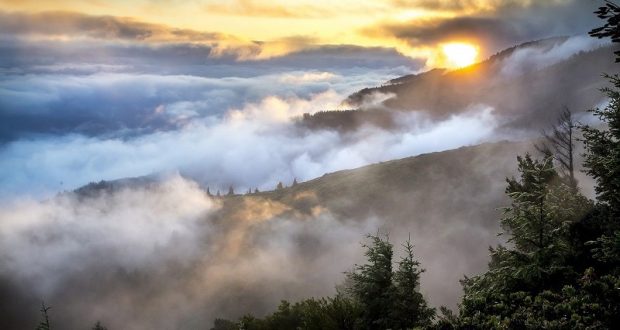By Brian David, U.C. Master Gardener, Mariposa
We know that wildfire smoke affects people’s health. Particles of burned plants and trees land on dust particles and are breathed into the lungs. However, this year’s Creek Fire not only affects you, it affects your plants.
This summer’s Sierra foothill smoke has limited gardening in part by imposing health restrictions on gardeners. In areas that were evacuated, it meant plants went without care outside conscientious acts of firefighters. Power outages, which often accompany wildfires, often result in irregular watering.
Plants, like people, need clean air for optimal health. The effects of smoke on plants can be tasted in fruits like grapes; wines produced from grapes developing during a wildfire will often have a smoky taste. Air pollution effects on plants have been documented since the 1940s, decreasing crop production and impacting the financial return on commercially grown produce. A combination of particulate matter and the low-lying ozone (O3) created by burning fossil fuels, can reduce yields of plants and trees by twenty percent.
Wildfire smoke may slow the development of garden plants or cause stress on their leaves. You may have smoke stressed plants if you find leaves losing their green color (chlorosis), leaf cell injury or death in the leaf (necrosis), irregular small dark spots on the leaves (stipples), brown, bronze or red sections on the leaf may also be the result of the plant’s pores (stoma) being overloaded with particles and ozone from the smoke.
Wildfires often require sprayed fire retardants to slow a fire. Long Term Fire Retardant (LTFR) is often composed of phosphates, sulfates, nitrogen and water. These elements suffocate the fire and fertilize the forest. The LTFR’s also alter the natural forest growth and wash into water ways increasing aquatic plant growth, which impacts aquatic animal development and survival. The best thing we can do for an environment with poor air quality is to grow more herbaceous plants.
Fall gardening in the Mother Lode can be like discovering green gold. Now is the time to prepare for your garden’s bright future. Soon rains will fall. The air will be clear and the land will revive. Planting our fall crops now allows their roots to drive deep into the soil maximizing fall and winter watering for vibrant foliage.
Consider planting nutrient dense vegetables like beets, broccoli, Brussels sprout, cabbage, carrots, cauliflower, collards, radish, kale, lettuce and mustard greens. Flowers like calendulas, primrose, snap dragons, and pansies will color your fall garden. Spring maturing bulbs like narcissus, daffodils, and brodiaea can go in now and do not need watering.
UC Master Gardeners of Mariposa County is located at 5009 Fairgrounds Rd., Mariposa. For more gardening and event information, visit them at cemariposa.ucanr.edu/Master_Gardener or on their Facebook page (UC Master Gardeners of Mariposa County.)
UC Master Gardeners staff a helpline serving Mariposa County, including Greeley Hill, Coulterville, and Lake Don Pedro. Please contact them at 209-966-7078 or via e-mail at mgmariposa@ucdavis.edu.
Listen to them on the radio at KRYZ 98.5 FM on Wednesdays at 2 p.m and Saturdays at 5 p.m.




